
The Ajanta Caves are 29 rock-cut Buddhist cave monuments dating from the second century BCE to about 480 CE in the Aurangabad district of Maharashtra state in India. Ajanta Caves are a UNESCO World Heritage Site. Universally regarded as masterpieces of Buddhist religious art, the caves include paintings and rock-cut sculptures described as among the finest surviving examples of ancient Indian art, particularly expressive paintings that present emotions through gesture, pose and form.

The word Yona in Pali and the Prakrits, and the analogue Yavana in Sanskrit and Yavanar in Tamil, were words used in Ancient India to designate Greek speakers. "Yona" and "Yavana" are transliterations of the Greek word for "Ionians", who were probably the first Greeks to be known in India.

The Kanheri Caves are a group of caves and rock-cut monuments cut into a massive basalt outcrop in the forests of the Sanjay Gandhi National Park, on the former island of Salsette in the western outskirts of Mumbai, India. They contain Buddhist sculptures and relief carvings, paintings and inscriptions, dating from the 1st century CE to the 10th century CE. Kanheri comes from the Sanskrit Krishnagiri, which means "black mountain".
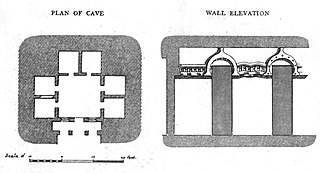
Vihāra generally refers to a Buddhist monastery for Buddhist renunciates, mostly in the Indian subcontinent. The concept is ancient and in early Sanskrit and Pali texts, it meant any arrangement of space or facilities for dwellings. The term evolved into an architectural concept wherein it refers to living quarters for monks with an open shared space or courtyard, particularly in Buddhism. The term is also found in Ajivika, Hindu and Jain monastic literature, usually referring to temporary refuge for wandering monks or nuns during the annual Indian monsoons. In modern Jainism, the monks continue to wander from town to town except during the rainy season (chaturmasya), and the term "vihara" refers to their wanderings.

A chaitya, chaitya hall, chaitya-griha, refers to a shrine, sanctuary, temple or prayer hall in Indian religions. The term is most common in Buddhism, where it refers to a space with a stupa and a rounded apse at the end opposite the entrance, and a high roof with a rounded profile. Strictly speaking, the chaitya is the stupa itself, and the Indian buildings are chaitya halls, but this distinction is often not observed. Outside India, the term is used by Buddhists for local styles of small stupa-like monuments in Nepal, Cambodia, Indonesia and elsewhere. In Thailand a stupa, not a stupa hall, is called a chedi. In the historical texts of Jainism and Hinduism, including those relating to architecture, chaitya refers to a temple, sanctuary or any sacred monument.

The Bagh Caves are a group of nine rock-cut monuments, situated among the southern slopes of the Vindhyas in Bagh town of Dhar district in Madhya Pradesh state in central India. These monuments are located at a distance of 97 km from Dhar town. These are renowned for mural paintings by master painters of ancient India. The use of the word "cave" is a bit of a misnomer, since these are not natural, but instead examples of Indian rock-cut architecture.
The Western Satraps, or Western Kshatrapas were Indo-Scythian (Saka) rulers of the western and central parts of India, between 35 and 415 CE. The Western Satraps were contemporaneous with the Kushans who ruled the northern part of the Indian subcontinent, and were possibly vassals of the Kushans. They were also contemporaneous with the Satavahana (Andhra) who ruled in Central India. They are called "Western Satraps" in modern historiography in order to differentiate them from the "Northern Satraps", who ruled in Punjab and Mathura until the 2nd century CE.
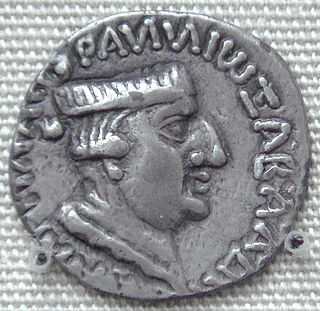
Nahapana, was an important ruler of the Western Kshatrapas, descendant of the Indo-Scythians, in northwestern India, who ruled during the 1st or 2nd century CE. According to one of his coins, he was the son of Bhumaka.
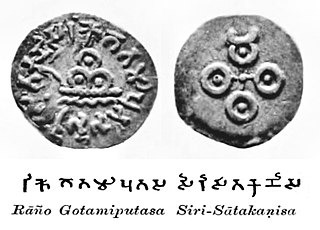
Gautamiputra Satakarni was a ruler of the Satavahana Empire in present-day Deccan region of India. He was mentioned as the important and greatest ruler of Satavahana Dynasty. He ruled in the 1st or 2nd century CE, although his exact period is uncertain. His reign is dated variously: 86-110 CE, c. 103-127 CE, 106-130 CE, or more recently and specifically ca. 60-85 CE.

The Nasik Caves, or Trirashmi Leni, are a group of 23 caves carved between the 1st century BCE and the 3rd century CE, though additional sculptures were added up to about the 6th century, reflecting changes in Buddhist devotional practices. The Buddhist sculptures are a significant group of early examples of Indian rock-cut architecture initially representing the Early Buddhist schools tradition.

Indian rock-cut architecture is more various and found in greater abundance in that country than any other form of rock-cut architecture around the world. Rock-cut architecture is the practice of creating a structure by carving it out of solid natural rock. Rock that is not part of the structure is removed until the only rock left makes up the architectural elements of the excavated interior. Indian rock-cut architecture is mostly religious in nature.
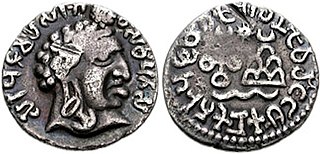
Vasishthiputra Pulumavi was a Satavahana king, and the son of Gautamiputra Satakarni. The new consensus for his reign is c. 85-125 CE, although it was earlier dated variously: 110–138 CE or 130–159 CE. He is also referred to as Vasishthiputra Sri Pulumavi. Ptolemy, the second century writer, refers to Pulumavi as Siriptolemaios, a contemporary of the Western satrap, Chastana.

Ushavadata, also known as Rishabhadatta, was a viceroy and son-in-law of the Western Kshatrapa ruler Nahapana, who ruled in western India.

The Pitalkhora Caves, in the Satmala range of the Western Ghats of Maharashtra, India, are an ancient Buddhist site consisting of 14 rock-cut cave monuments which date back to the third century BCE, making them one of the earliest examples of rock-cut architecture in India. Located about 40 kilometers from Ellora, the site is reached by a steep climb down a flight of concrete stairs, past a waterfall next to the caves.

The Shivneri Caves are artificial caves dug for Buddhist monks circa the 1st century CE. These are now famous tourist attractions located on Shivneri Hill, about 2 km Southwest of Junnar, India. Other caves around the city of Junnar are: Manmodi Caves, Lenyadri, and the Tulja Caves.

The Manmodi Caves are a complex of a rock-cut caves about 3 km to the south of the city of Junnar in India. Other caves surrounding the city of Junnar are: Tulja Caves, Shivneri Caves and Lenyadri caves.

The Nasik inscription of Ushavadata is an inscription made in the Nasik Caves by Ushavadata, a son-in-law of the Western Satraps ruler Nahapana, in the years circa 120 CE. It is the earliest known instance of the usage of Sanskrit, although a rather hybrid form, in western India. It also documents the Indian tradition of dana (charity) to Brahmins, Buddhists and of building infrastructure to serve pilgrims and the general public by the 2nd-century CE.

The Buddhist caves in India. Maharashtra state Aurangabad Dist. Ellora caves form an important part of Indian rock-cut architecture, and are among the most prolific examples of rock-cut architecture around the world. There are more than 1,500 known rock cut structures in India, out of which about 1000 were made by Buddhists, 300 by Hindus, and 200 by Jains. Many of these structures contain works of art of global importance, and many later caves from the Mahayana period are adorned with exquisite stone carvings. These ancient and medieval structures represent significant achievements of structural engineering and craftsmanship.
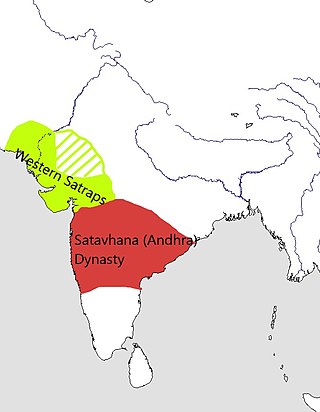
The Saka-Satavahana Wars were a series of conflicts fought between the Saka ksatraps and the Satavahanas during the 1st-2nd century CE. Both sides achieved success at varying points during the conflicts, but in the end, it was the Satvahanas which prevailed. However, constant wars with the Sakas severely weakened them and was a major contributor in their fall.

Indo-Scythian art developed under the various dynasties of Indo-Scythian rulers in northwestern India, from the 1st century BCE to the early 5th century CE, encompassing the productions of the early Indo-Scythians, the Northern Satraps and the Western Satraps. It follows the development of Indo-Greek art in northwestern India. The Scythians in India were ultimately replaced by the Kushan Empire and the Gupta Empire, whose art form appear in Kushan art and Gupta art.




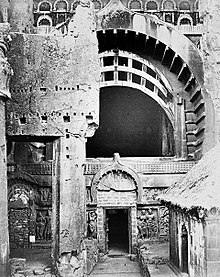

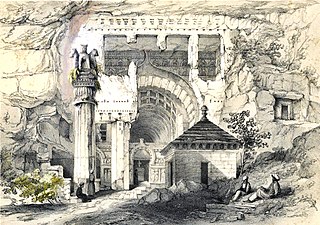

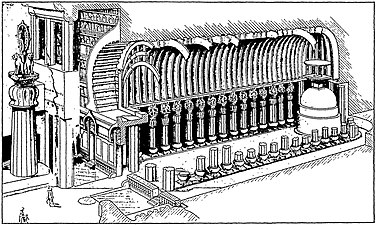


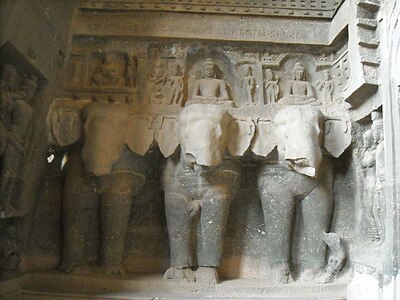





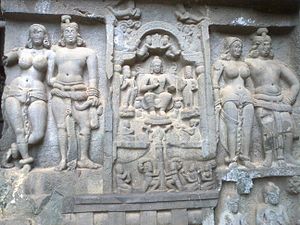

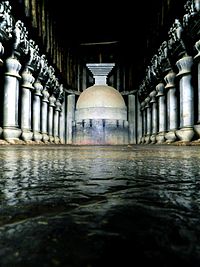
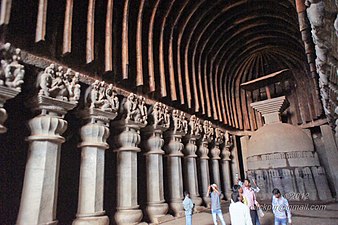



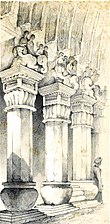

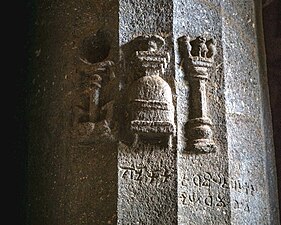



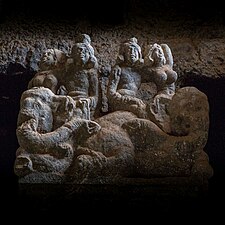




![Left pillar No.9 of the Great Chatya. This pillar was donated by a Yavana circa 120 CE, like five other pillars. The inscription of this pillar reads: "Dhenukakata Yavanasa/ Yasavadhanana[m]/ thabo dana[m]" i.e. "(This) pillar (is) the gift of the Yavana Yasavadhana from Denukakata". Below: detail of the word "Ya-va-na-sa" in old Brahmi script: . Karla Caves Great Chaitya Left pillar No9.jpg](http://upload.wikimedia.org/wikipedia/commons/thumb/1/1a/Karla_Caves_Great_Chaitya_Left_pillar_No9.jpg/251px-Karla_Caves_Great_Chaitya_Left_pillar_No9.jpg)

































